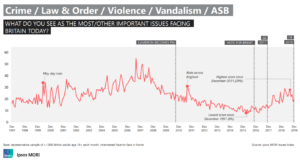In the early hours of the first day of January 2019, a man was killed while working as a security guard at a New Year’s Eve party after he intervened to help a colleague involved in a struggle. In February, a man was murdered after refusing to give a stranger a cigarette in an off-licence. In March, a teenager was stabbed to death by another teenager in an alleyway. In April, a woman was found beaten to death in a flat. Her partner was charged with her murder.
These are some of the Londoners who lost their lives to violence last year. Their deaths illustrate the human consequences of violence in the capital, to the victims, those who loved them and their communities. They bring to the fore the pressing question – how can we prevent these tragic incidents from happening?
After almost a decade of decline, in recent years, data has pointed to increases in more serious crime-types, particularly, violence in England and Wales. Confronted with this trend and the human loss and suffering that it represents, crime in general and violence in particular has become an issue of mounting concern in the UK, both for the public and policy makers. Media reports on increasing violence in the Guardian have more than doubled since 2012 and, as the Ipsos Mori issues index shows, public concerns about crime have risen in parallel. [i]

The UK Government has taken action, from increasing funding for police forces, to setting up Violence Reduction Units across the country. But how well do we actually understand the problem we are seeking to address? And do we know what will actually work to prevent it? Improvements in the way the police record crime in England and Wales in recent years have made it difficult rely on our primary data source (police recorded crime) in order to interpret and understand trends. In addition, violence encapsulates a broad and complex set of behaviours, which can be both difficult to measure and understand.
Without understanding violence, where it’s happening, to whom and why, efforts to tackle it are unlikely to be effective. As a result, since last year, we have been working with the Mayor of London’s Violence Reduction Unit to carry out the first ever capital-wide assessment of violence.
In our new report we bring together data analysis and new research from leading academics to complement the voices of London’s communities with evidence of large-scale patterns and trends, bringing to the fore new insights to inform decision making.
For example, while violence in London has increased in recent years, new research shows this increase has been highly geographically concentrated, heavily clustered in a tiny proportion of small geographical units or (Lower Layer Super Output Areas, LSOAs), which contain a maximum of 3000 residents. Just six (i.e. fewer than 1 per cent) of all of London’s LSOAs showed a large and increasing violent crime rate between 2013 and 2017 and violence actually decreased in many areas over this period. In response to this finding, the VRU is proposing to fund a new violence reduction programme that delivers interventions in specific local neighbourhoods and estates that are most at risk of violence.
This week, we’ll be showing how the principles of BIT’s approach, empiricism and an understanding of human behaviour, can push the boundaries beyond “nudge” and help us understand and respond to one of the most complex social issues we face: crime. Look out for four more posts, including reflections on setting up a team inside the world’s oldest police force and a guest blog from Professor Tom Kirchmaier at the London School of Economics.
[i] Humphreys, D. K., Esposti, M. D., Gardner, F., & Shepherd, J. (2019). Violence in England and Wales: does media reporting match the data? BMJ, 367, l6040. https://doi.org/10.1136/bmj.l6040.




